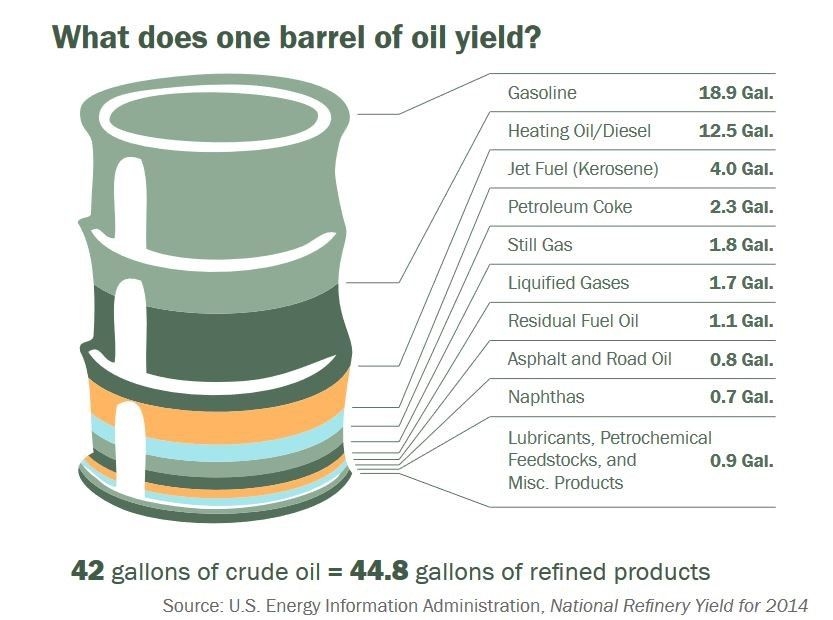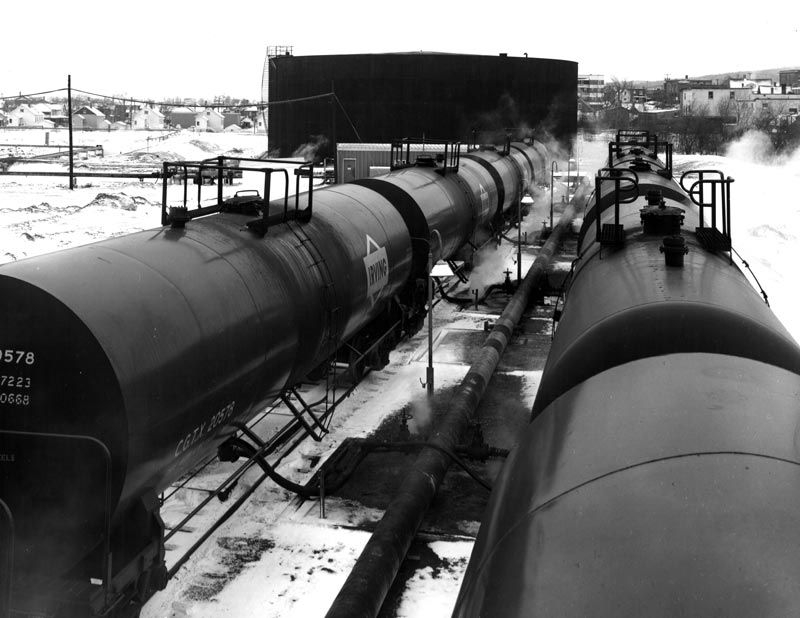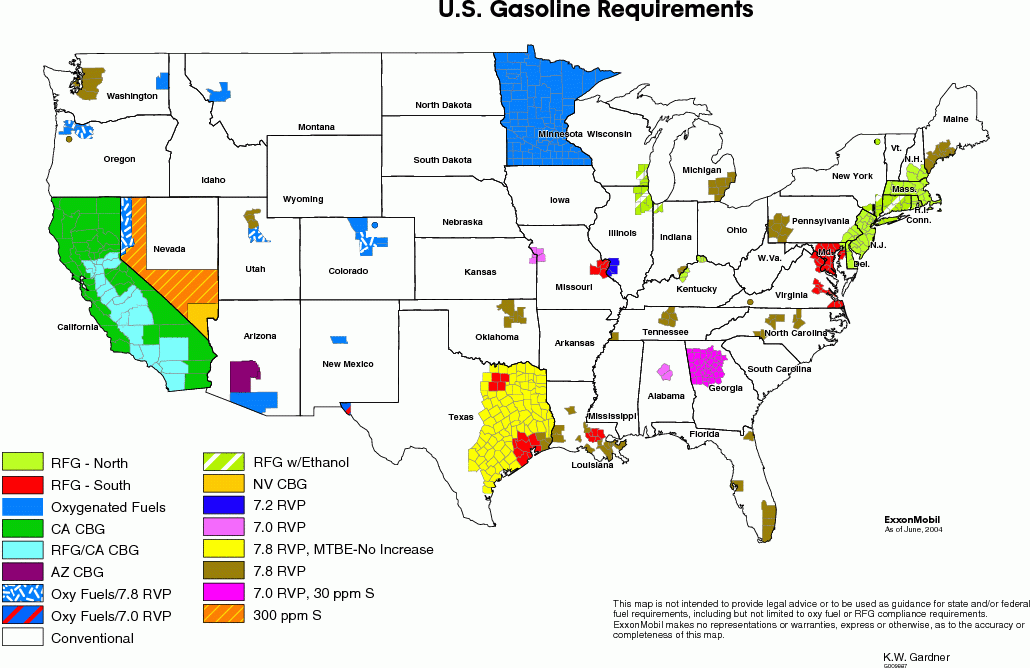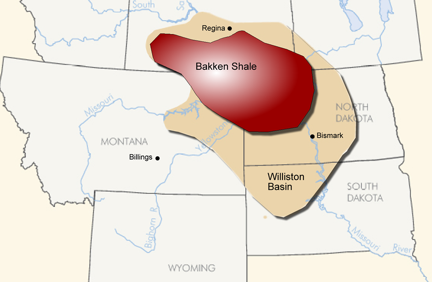Oil is a sticky, messy thing.
Some people hate it. Some people love it. We all need it.
Petroleum oil is the most flexible of carbon based energy sources. It is energy dense; the only natural substance that carries more energy per pound is uranium. Petroleum is liquid, and in its natural state, has little use. Only after the refining process, fractional distillation - essentially cooking processes to create fuels and chemical compounds - does petroleum become useful.
Not only can it be a fuel, it is also a key component in plastics, roads, building materials, medicines, the list goes on. Thousands of chemical compounds and products start from a barrel of crude oil.
Until the industrial era, petroleum was nothing but an interesting black liquid that oozed from some layers of exposed earth. The Babylonians used crude oil asphalt to construct watertight walls and roofs over 4,000 years ago. Since then, people collected oil seeping from the ground and used it for different purposes in construction and candles. The first oil refinery appeared in 1856 in Poland, built by pharmacist Jan Józef Ignacy Łukasiewicz. That refinery made kerosene oil for lamps as a replacement or supplement for whale oil.
Petroleum remained a niche product until the development of the internal combustion engine at the end of the 19th century, first burning gasoline and then fuel oil. As quickly as the automotive industry grew, so did the oil industry and the resulting supply chain.
The main transportation fuels, gasoline, diesel and Jet A, are universal and fungible products. Universal in the sense that other than the additives and impurities in the fuel, a gallon of diesel in the US is the same as a gallon in Africa, China or Europe. Refined petroleum products are true commodities that meet specific specifications. Commodity products trade in contracts to buy/sell a specific quantity at a specific price delivered to a specific location. These contracts trade in commodity exchanges like the NYMEX, ICE, and others.
Because of the commodity nature of the raw material and the finished products, the price of crude directly affects the cost of the underlying products. However, logistics costs not only add to the costs, those costs complicate the final cost of the commodities to the final user of the product. Moreover, the dizzying array of trade restrictions, sanctions, tariffs, regulations, taxes, political and social issues add more cost at the pump, perhaps more than the cost of the basic product itself.
The global oil supply chain system is not only complex, it is complicated by actions of other systems. The basic process of getting oil out of the ground, moved to a refinery, processed, then moved through a network to the customer is simple in schematic form, but becomes complex and difficult to understand and model when all of the outside forces of safety, environment and political interference come into view. Politics and policy constrain the flow of the fuel, changing the price at the pump in ways that few fully understand.
The Power of Understanding
In late 2011, a client asked us to help them prepare for their next budgeting cycle. The rapid rise in diesel costs in late 2007 and early 2008 crushed that company’s profits; only through drastic intervention by management did the company survive. The company budgeted for continued high oil prices in 2009, only to watch the cost of fuel drop in early 2009 and rise by the middle of that year. The client struggled to forecast the cost of fuel across their network, finding cost swings in different parts of the country that defied logic.
As part of our normal operating methods, we collaborated with the client to develop internal knowledge in both the financial and operations teams, teaching them to understand the underlying components of the petroleum supply chain, how networks differed across the US, and how those differences affected the cost of fuel. Together, we researched the history of the US petroleum market and the exploration, production, refining and distribution segments. We studied the macro economic issues that controlled the cost of crude. We developed rational understandings of the effects of upstream and downstream networks on the costs of the refined products. Armed with that knowledge, the client team not only developed reasonable and accurate budgets, but also developed tactical decisions that helped lower their overall fuel costs.
Transportation is a key part of any supply chain, driving as much as half of the total cost of distribution. Fuel is a major cost segment of transportation cost. Any superior supply chain manager carefully develops an understanding of how the cost of oil affects their operations. Therefore, understanding the Petroleum Supply Chain is a fundamental skill for any successful Supply Chain Leader.
Articles in This Series
Articles in This Series
Will Diesel Ever Reach $5 per Gallon?
In the middle of 2008, the average price for over-the-road diesel came close to the lofty price of $5 per gallon. The week of July 14, the average price across the country was $4.77 per gallon. That week, in California and in a few New England states the price peaked above $5. From 2011 through the end of 2013, the average national price was more often over the $4 per gallon mark than it was under. Read More

So, how does an oil company lose money?
In early 2012, a New York State based client asked us if we thought that diesel prices would reach $5 per gallon. We looked at the situation and determined that the price should stay under $4.50 per gallon of diesel in the Northeast US unless something happened that altered the balance of refining capacity in the Delaware Valley. Read More
Classification and Oil Volatility
If you Google the term "oil volatility," you will find pages of entries about the OVX on the CBOE (that would be the Oil Volatility Index on the Chicago Board Options Exchange). Read More

Dodged Bullet: Trains to the Rescue
In 2012, a number of events had to happen for Northeast Fuel prices to rise above $4.50 for gasoline and $5.00 for diesel. But not all the bad that could have happened did happen. Read More
Revisiting Northeast Diesel Prices
In March 2012, that question inspired an eight-part series about diesel and gasoline prices in the Northeast US that appeared here at We Are The Practitioners. Six months later, and to no one’s surprise, a number of events kept gasoline and diesel from reaching the $5 mark. Read More

The Gasoline BOBs – CBOB and RBOB (and CARBOB)
Long ago, in the bad old days when our cars were big, fuel was cheap, and we actually put lead in the gasoline, there was conventional gasoline. Conventional gasoline was just that—gasoline. Read More

California Gas Price Woes
Call it the cruel truth of supply and demand—with a West Coast twist. In 2012, the major news networks all ran stories about a jump in fuel prices in the Golden State. Read More
Are We Limited or Limitless?
While doing research on the topic of oil refining, I found a blog by a geology graduate student, Derik Andreoli. Derik’s blog, The Seventh Fold, is subtitled, A Critical Commentary on our Energy Future. Read More
Oil’s Path of Least Resistance
In February 2012, a crew of environmental lobbyists like the Sierra Club’s Executive Director Michael Brune and President Allison Chin, along with activists like Robert Kennedy Jr. and actress Daryl Hannah, protested the construction of the Keystone XL pipeline. Read More
What is Worth More, Raw Material or Finished Product?
Oil, like any commodity, has different prices. Prices vary according to the grade and location of the stock. Oil chemistry plays a huge part in the refining process, and the yield of finished products from a given barrel of crude. Read More
Dodged Bullet: Convert the Refinery Process
In 2012, a number of events had to occur for Northeast Fuel prices to rise above $4.50 for gasoline and $5.00 for diesel. But not all the bad that could have happened did happen. This article is part four in a series that examines the questions that influence pricing: Read More

Keystone and the Buffet Rule
On August 14, 2011 the New York Times published an op-ed by the Oracle of Omaha entitled, "Stop Coddling the Super-Rich." Read More
Politics and Ignorance…
It was no surprise when the Obama administration chose to put off the decision on the route of the Keystone XL pipeline until after the 2016 presidential election. There was a political agenda afoot, and to deny that politics was at play is to be blind to the facts. Read More
Shifting Markets
Commercial markets are like grains of sand on the beach. The sand stays in place until the next wave comes up and moves it around. The US energy markets are feeling a wave of change, shifting the calculus of not only oil prices, but natural gas prices too. Read More


